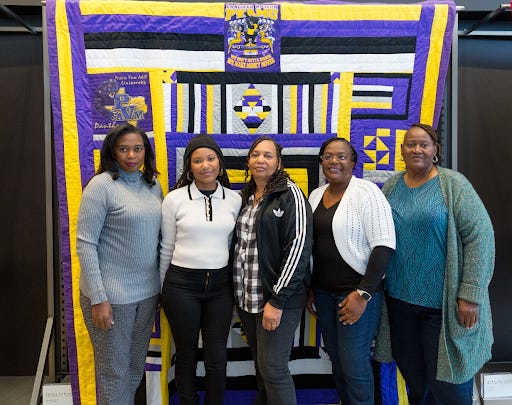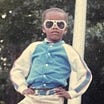
Parable of the Sewers
For generations, the Black women of Gee’s Bend, Alabama, have used quilts to chronicle the history of their community.

In the heart of Wilcox County, nestled in the Black Belt of west Alabama, lies the unassuming town of Boykin — a name imposed on this settlement by the federal government in 1949. But while Boykin — more commonly known among its 300 or so locals as Gee’s Bend — is celebrated for its hometown heroes, like “Catfish Blues” singer Robert Petway, or for only having one road that leads into town, its claim to fame is the Quilters of Gee’s Bend: a cadre of Black women whose critically acclaimed creations have been recognized as “some of the most significant artistic contributions to American art history.”
What makes the internationally renowned masterpieces found in Gee’s Bend unique are the longstanding traditions the quilters inherited — with poverty, unyielding racism and geographic isolation each contributing to the valiant stories they’ve bore since the nineteenth century.
“Back in the day, my mom sewed to keep us warm,” quilter Sharon Williams told ContrabandCamp. “We didn't have any idea that the sewing we were doing at Gee’s Bend would turn out to be what it is. We did it to keep warm.”
Tasked with keeping those merciless Alabama winters at bay, the early women of Gee’s Bend never allowed the grueling days they spent toiling away in the fields alongside their enslaved husbands and loved ones to deter them from their domestic duties. Despite exhaustion and limited resources, they transformed everything from worn-out work clothes to flour sacks into elaborate quilts, often recycling all that remained of their long-lost loved ones’ possessions into artistic expressions that brought comfort, distinction and warmth to their families.
Thankfully, the residents of Gee’s Bend no longer live under those extreme socioeconomic constraints. But that doesn’t mean that their methods — an amalgamation of contrasting colors, reused materials, and improvisation — have changed since their earliest quilts first originated.
“The reading [of quilt patterns] has been passed down from my grandma to my mom. She taught me the way to sew and I don't want to lose what she taught me,” Williams said. “I just love the way that it keeps going. I have daughters and I'm teaching them to keep the generation going so we can keep it and take it as far as we can take it. I hope to bring it to my children, their children, and maybe their grandchildren. I love the way my mom taught me.”
Fellow Gee’s Bend quilters Francesca Charley and LaKarian Pettway note that with their survival no longer at stake, it's much easier to find joy while continuing to create their life’s work.
“Of course, we’ll never forget our roots,” Charley told ContrabandCamp. “But it’s definitely a lot more fun to do now that it is no longer based on survival. Now it's just about spreading the art and keeping the tradition going so more people know about it.”
“To add to [what she said], it has developed tremendously,” Pettway said. “But one major way that I can point out is creativity. So before, we had to use what we had. Basic things we had laying around — such as old clothing and flour sacks — just to put quilts together. Now, we’re able to buy different color fabrics and create quilts solely because we have specific patterns or styles in mind.”
This improvisational style, known locally as “my way,” has been passed down from generation to generation — from the Lucy Mooneys of yesteryear to the Caster Pettways of today. But aside from allowing for more robust creative expression, the infusion of new colors and fabrics has also brought with it increased popularity — as well as critical acclaim.
Once only found in the same unheated homes they were created in, strewn across the banks of the Alabama River, the astonishing work of the Quilters of Gee’s Bend was first propelled into the national spotlight in 1966. With the Civil Rights Movement serving as a backdrop, the Freedom Quilting Bee, led by Estelle Witherspoon, was established by approximately 60 quilters to combat the rampant poverty that ravaged Wilcox County’s predominantly Black population. This alliance, fueled by their unwavering commitment to economic independence, helped usher in a new era that capitalized on New York City’s thriving art and fashion scene in order to reinvest back into the Gee’s Bend community.
Soon after, an auction was held at a photographer’s studio in Manhattan, in which out of 100 available quilts, 95 were sold. The resounding success of this event created the demand for subsequent auctions, which were touted by both celebrities and renowned purveyors of fashion and art, like magazine editor Diana Vreeland — who helped publicize the quilts in Vogue magazine — and cabaret singer Mabel Mercer. In time, these quilts would be sold in luxury department stores like Bloomingdale’s and Saks Fifth Avenue before eventually finding permanent homes in over 40 museums across three different continents.
“It means so much to me knowing that we are finally getting the recognition that is so well deserved and flourishing at such a level,” Pettway said. “It's just an amazing feeling.”
In 2002, the tireless work of the Quilters of Gee’s Bend culminated in “The Quilts of Gee’s Bend,” a “miraculous” exhibition that premiered at the Museum of Fine Arts in Houston and featured “over sixty extraordinary quilts that were made between 1930 and 2000.” This exhibition would go on to be displayed at 11 other museums throughout the country, with even more accolades to follow.
In 2006, as part of its “American Treasures” series, the U.S. Postal Service announced the sale of 10 commemorative stamps honoring the Quilters of Gee’s Bend. Subsequent awards and recognition include theater productions, three National Heritage fellowships — considered “the nation’s highest honor for folk and traditional arts” — and being named the first honorees of Adidas’ 2025 Honoring Black Excellence program. Through this program, Adidas recently unveiled a limited-edition collection of NCAA jerseys inspired by the cultural artistry and unparalleled storytelling of five generations of quilters from Gee’s Bend.
“We have never done anything like this before,” Charley said. “To be given the opportunity to do this, and for the world to see a different style of what we're doing because we've never designed jerseys before this. This was definitely a new area for us.”
Yet for everything they’ve accomplished since their inception over 80 years ago, the Quilters of Gee’s Bend remain committed to not only protecting their legacy but expanding upon it to ensure that their profound cultural impact — as well as the community their work amplifies and extols — endures for generations to come.
That means embracing new traditions.
“I believe the Quilters of Gee's Bend are the ones who learned from our parents.” Andrea P. Williams told ContrabandCamp. “Not only learned from their parents but kept it going through generations of daughters. However, our daughters are not the only ones quilting. We have sons who also quilt. We have boys who also sew. So just to keep it going throughout the generations of our family. [Pass it] down from generation to generation.”
“I'm already a part of generation five. If I do end up having children, I definitely plan on continuing this because it's such a beautiful art form,” Charley said. “Do we really have a choice to let it stop when you really think about it? So many people love [our quilts]. I love receiving feedback from everyone and having all these different magazines reach out to us. It's crazy that it's gotten this far. We're not taking [any of this] for granted. So, we hope to continue and make everyone proud in the process.”
But even with new traditions, the Quilters of Gee’s Bend ensure that the history of their life’s work remains at the forefront.
“I believe what everyone else said about keeping the history going,” Pettway said. “Our legacy revolves around the history. Going from a necessity to a work of art that can still be used to keep us warm but can also hang on our walls as decoration. There's love and joy sewn into every one of our quilts. Like Franchesca said, I will teach my future children the art of quilting and make sure that they understand its importance as a whole.”






I’m proud to own one of these quilts. Happy that they are not letting the tradition and artistry die.
I'm so glad to have read this article, thank you Mr. Connor.